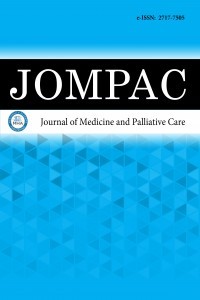Makine öğrenmesi modeli nasıl açıklanır: HbA1c sınıflama örneği
Makine öğrenmesi, açıklanabilir yapay zekâ, glikolize hemoglobin
How to explain a machine learning model: HbA1c classification example
___
- Haymond S, McCudden C. Rise of the Machines: artificial ıntelligence and the clinical laboratory. J Appl Lab Med 2021; 6: 1640–54.
- Habehh H, Gohel S. Machine learning in healthcare. Curr Genomics. 2021; 22: 291-300.
- Zhang Y, Weng Y, Lund J. Applications of explainable artificial ıntelligence in diagnosis and surgery. Diagnostics 2022; 12: 237.
- Arbelaez Ossa L Starke G, Lorenzini G, Vogt JE, Shaw DM, Elger BS. Re-focusing explainability in medicine. Digit Heal 2022; 8: 205520762210744.
- Linardatos P, Papastefanopoulos V, Kotsiantis S. Explainable ai: a review of machine learning interpretability methods. Entropy 2020; 23: 18.
- Ghassemi M, Oakden-Rayner L, Beam AL. The false hope of current approaches to explainable artificial intelligence in health care. Lancet Digit Heal 2021; 3: e745-50.
- Langs HG, Denk H, Zatloukal K, Müller H. Causability and explainability of artificial intelligence in medicine. Wiley Interdiscip Rev Data Min Knowl Discov 2019; 9: e1312.
- Sherwani SI, Khan HA, Ekhzaimy A, Masood A, Sakharkar MK. Significance of HbA1c test in diagnosis and prognosis of diabetic patients. Biomark Insights 2016; 11: 95–104.
- National Center for Health Statistics (NCHS). National Health and Nutrition Examination Survey Data. Hyattsville, MD; U.S. Department of Health and Human Services, Centers for Disease Control and Prevention. [December 2022][https://www.cdc.gov/nchs/nhanes/ index.htm]
- American Diabetes Association Professional Practice Committee (2022). 2. Classification and Diagnosis of Diabetes: Standards of Medical Care in Diabetes. Diabetes care 2022; 45: 17-38.
- R Core Team R. A language and environment for statistical computing. https://www.r-project.org/ [December 2022].
- Ledell E, Poirier S. H2O AutoML: scalable automatic machine learning [Internet]. AutoML Org; 2020. [https://H2O.ai/platform/H2O-automl/] [December 2022]
- Biecek P. DALEX: Explainers for Complex Predictive Models in R. J Mach Learn Res 2018; 19: 1-5.
- Kursa MB, Rudnicki WR. Feature selection with the boruta package. J Stat Software 2010;36:1–13.
- Hand DJ, Till RJ. A simple generalisation of the area under the ROC curve for multiple class classification problems. Mach Learn 2001; 45: 171-86.
- Wei P, Lu Z, Song J. Variable importance analysis: A comprehensive review. Reliab Eng Syst Saf 2015; 142: 399-432.
- Antwarg L, Miller RM, Shapira B, Rokach L. Explaining anomalies detected by autoencoders using Shapley Additive Explanations. Expert Syst Appl 2021; 186: 115736.
- Staniak M, Biecek P. Explanations of model predictions with live and breakDown packages. R Journal 2019; 10: 395-409.
- Nathan DM, Kuenen J, Borg R, Zheng H, Schoenfeld D, Heine RJ. Translating the A1C assay into estimated average glucose values. Diabetes Care 2008; 31: 1473-8.
- Feller S, Boeing H, Pischon T. Body mass index waist circumference and the risk of type 2 diabetes mellitus: implications for routine clinical practice. Dtsch Arztebl Int 2010: 470-6.
- Shimizu T, Suda K, Maki S, et al. Efficacy of a machine learning-based approach in predicting neurological prognosis of cervical spinal cord injury patients following urgent surgery within 24 h after injury. J Clin Neurosci Off J Neurosurg Soc Australas 2023; 107: 150-6.
- Başlangıç: 2020
- Yayıncı: MediHealth Academy Yayıncılık
Mehmet AĞAR, Asena AYAR MADENLİ, Nur DOKUZEYLÜL GÜNGÖR, Şebnem ALANYA TOSUN
Mehmet Sait ALTINTAŞ, Yasin YÜKSEL, Deniz DEMIRCI, Taskin RAKİCİ, Baris DEMİRKOL, Turgut KARABAĞ, Erdoğan ÇETİNKAYA
Pulmoner arteriyel hipertansiyonlu hastalarda vagal-nöroimmünomodülasyon endeksinin rolü
Süleyman KALAYCI, Ekrem ŞAHAN, Omaç TÜFEKÇİOĞLU
Birsen DOĞANAY, Ozlem OZCAN CELEBİ
Dil kanserli hastalarda preoperatif neoadjuvan kemoterapinin prognostik rolü
Süleyman CEBECİ, Emirhan AKYOL, Utku AYDİL, Alper DİLCİ, Aytuğ ÜNER
Kalıcı diyaliz kateterlerinin uzun dönem sonuçları: tek merkez tecrübemiz
Venöz rezeksiyonlu pankreatikoduodenektomi sonuçları: 11 olgu ile tek merkez deneyimi
Dursun Burak ÖZDEMİR, Ahmet KARAYİĞİT, Hayrettin DİZEN, Ümit ÖZDEMİR, İhsan Burak KARAKAYA, Barış TÜRKER, Cüneyt AKYÜZ, Murat ULAŞ, İlter OZER, Bülent ÜNAL
Rektal kanser cerrahisinde koruyucu ileostomi, koruyucu ileostomi gerçekten geçici mi?
Cemal ULUSOY, Mehmet Güray DUMAN, Sıla GÜÇLÜ METE, Andrej NİKOLOVSKİ
HPV DNA pozitif olguların servikal smear ile korelasyon sonuçları her zaman uyumlu mudur?
